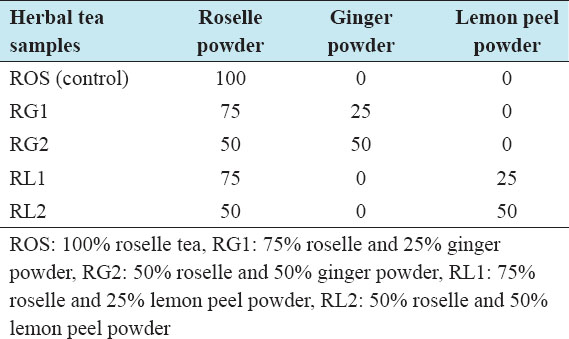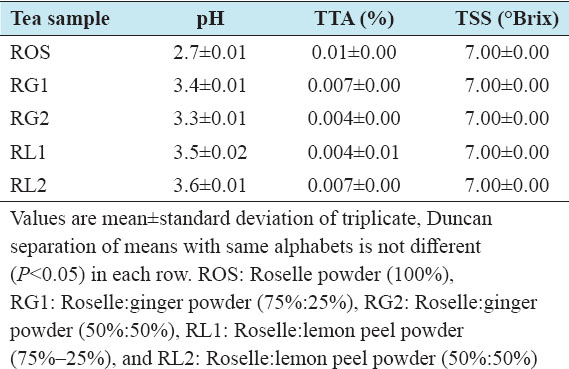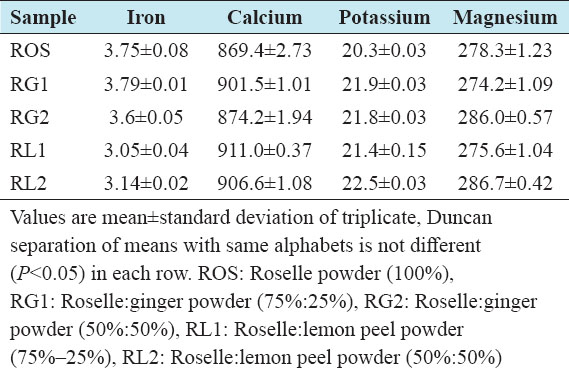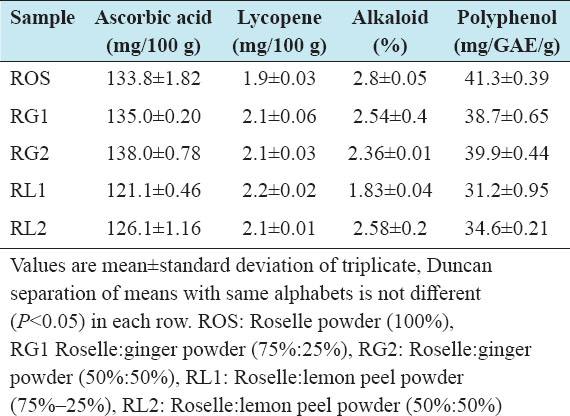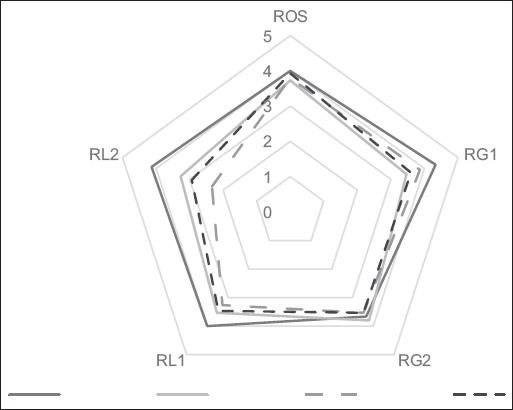1. Katiyar S, Mukhtar H. Tea in chemoprevention of cancer. Int J Oncol 1996;8:221-38.
2. Bansode PA. Total flavonoid content of commonly consumed teas in India. World J Pharm Res 2015;4:874-81.
3. Namita P, Mukesh R, Vijay KJ. Camellia sinensis (green tea):A review. Glob J Pharmacol 2012;6:52-9.
4. Joseph AD, Adogbo G. Processing and packaging of Hibiscus sabdariffa for preservation of nutritional constituents. Int J Sci Eng Res 2015;4:532-6.
5. Vagiri DS, Salim OP, Khan HG. Nutritional component of roselle calyx. J Pharmacol 2017;12:43-8.
6. Babalola S. Chemical Analysis of Roselle Leaf (Hibiscus sabdariffa), in Proceeding of 24th Annual Conference of Nigerian Institute of Food Science and Technology;2000. p. 228-9.
7. Mahadevan N, Shivali N, Pradeep K. Hibiscus sabdariffa-an overview of natural product radiance. World J Agric Sci 2009;8:77-83.
8. Padwal R, Straus S, McAlister F. Evidence based management of hypertension;cardiovascular risk factors and their effects on the decision to treat hypertension. J Med Sci 2001;322:801-977.
9. Ghayur MN, Gilani AH, Afridi MB, Houghton PJ. Cardiovascular effects of ginger aqueous extract and its phenolic constituents are mediated through multiple pathways. Vascul Pharmacol 2005;43:234-41.
10. Shirin AP, Jamuna P. Chemical composition and antioxidant properties of ginger root (Zingiber officinale). J Med Plants Res 2010;4:2674-9.
11. Ali BH, Blunden G, Tanira MO, Nemmar A. Some phytochemical, pharmacological and toxicological properties of ginger (Zingiber officinale Roscoe):A review of recent research. Food Chem Toxicol 2008;46:409-20.
12. Ali J, Das B, Saikia T. Antimicrobial activity of lemon peel (Citrus limon) extract. Int J Curr Pharm Res 2017;9:79-82.
13. Shahnah SM, Ali S, Ansari H, Bagri P. New sequiterpene derivative from fruit peel of Citrus limon (Linn) Burn. f. Sci Pharm 2007;75:165-70.
14. Rawson NE, Ho CT, Li S. Efficacious anti-cancer property of flavonoids from citrus peels. Food Sci Hum Wellness 2014;3:104-9.
15. Delgado-Vargas F, Parcedes L. Natural Colorants for Food and Nutraceutical Uses. Boca Raton:CRC Press, LLC;2003. 344.
16. Ogbuile JN, Ojiehior SI, Isu NR, Njoku HO. Effects of chemical and physical treatment on shelf-life of fermented African oil bean seed (Ugba). Niger J Biotechnol 1993;22:112-6.
17. Adelekan AO, Arisa NU, Alamu AE, Adebayo YO, Popoola GJ. Production and acceptability of fruit enhanced zobo drink. Food Sci Technol Lett 2014;5:46-51.
18. Akanbi WB, Olaniyan AB, Togun AO, Hupeju AE, Alaniran OA. The effects of organic fertilizer on growth, calyx yield and quality of roselle (Hibiscus sabdariff). Eurasian J Sustain Agric 2009;3:652-7.
19. Jabeur I, Pereira E, Barros L, Calhelha RC, SokovićM, Oliveira MB, et al. Hibiscus sabdariffa L. As a source of nutrients, bioactive compounds and colouring agents. Food Res Int 2017;100:717-23.
20. Association of Official Analytical Chemist. Official Methods of Analysis. 18th ed. Gaithersburg, Maryland, USA:Association of Official Analytical Chemist;2005.
21. Association of Official Analytical Chemists. Official Methods of Analysis. 17th ed. Gaithersburg, Maryland, USA:Association of Official Analytical Chemists;2000.
22. Junior JL, Malavolta E. Determinacao fotometrica de acido ascorbico. An ESALQ 1950;7:115-29.
23. Harborne JB. A Guide to Modern Techniques of Plant Analysis. London:Chapman and Hall;2000. 40-75.
24. Singleton VL, Rossi JA. Colorimetry of total phenolics with phosphomolybdic-phosphotungstic acid reagents. Am J Enol Vitic 1965;16:144-58.
25. Harbone JB. Phytochemical Methods:A Guide to Modern Techniques of Plant Analysis. New York:Chapman and Hall Publication;1973. 267-70.
26. Meilgaard MC, Carr TB, Civille GV. Sensory Evaluation Technique. 2nd ed. Boca Raton, Florida:CRC Press;1991.
27. IBM SPSS Statistic 20.0. Chicago, IL, USA:SPSS Inc;2011.
28. Ajayi OA, Lessor AG, Akinwunmi OO. Quality evaluation of zobo (Hibiscus sabdariffa) juice preserved with Moringa (Moringa oleifera) or ginger (Zingiber officinale) extracts at different storage conditions. J Microbiol Biotechnol Food Sci 2016;6:730-6.
29. European Tea Committee and European Herbal Infusions Association. Tea and Herbal Infusions Europe, Version 2. Available from:http://www.thie-online.eu. [Last accessed on 2019 Dec 17].
30. Fasoyiro SB, Ashaye OA, Adeola A, Samuel FO. Chemical and storability of fruit-flavoured (Hibiscus sabdariffa) drinks. World J Agric Sci 2005;2:165-8.
31. Bamishaiye E. The nutritional quality of three varieties of zobo (Hibiscus sabdarrifa) subjected to the same preparation condition. Am J Food Technol 2011;6:705-8.
32. Adesokan I, Abiola OP, Adigun MO, Anifowose OA. Analysis of quality attributes of Hibiscus sabdariffa (zobo) drinks blended with aqueous extracts of ginger and garlic. Afr J Sci 2013;7:174-7.
33. Bolade MK, Oluwalana IB, Ojo O. Commercial practice of roselle (Hibiscus sabdariffa L.) Beverage production:Optimization of hot water extraction and sweetness level. World J Agric Sci 2009;5:126-31.
34. Omemu AM, Edema MO, Atayese AO, Obadina AO. A survey of the microflora of Hibiscus sabdariffa (Roselle) and the resulting zobo juice. Afr J Biotechnol 2006;4:254-9.
35. Mohamed BB, Sulaiman AA, Dahab AA. Roselle (Hibiscus sabdariffa L.) in Sudan, cultivation and their uses. Bull Environ Pharmacol Life Sci 2012;1:48-54.
36. Mohammed SF, Gimba IK, Bahago EJ. Production and quality evaluation of instant Sorrel (Zobo) drink produced by infusion, dehydration and size reduction methods. J Nutr Health Sci 2017;4:205.
37. Berrazaga I, Micard V, Gueugneau M, Walrand S. The role of the anabolic properties of plant-versus animal-based protein sources in supporting muscle mass maintenance:A critical review. Nutrients 2019;11:E1825.
38. Morton JF. Health benefits of roselle (Hibiscus sabdariffa). J Pharm Biol Sci 1999;9:124-9.
39. Pourmorad F, Husseinimehr SJ, Shahabimajd N. Antioxidant, phenol and flavonoid contents of some selected Iranian medicinal plants. Afr J Biotechnol 2006;5:1142-5.
40. Okereke CN, Iroka FC, Chukwuma MO. Phytochemical analysis and medicinal uses of Hibiscus sabdariffa. Int J Herb Med 2015;2:16-9.
41. Gan J, Feng Y, He Z, Li X, Zhang H. Correlations between antioxidant activity and alkaloids and phenols of maca (Lepidium meyenii). J Food Qual 2017;2017:10.

